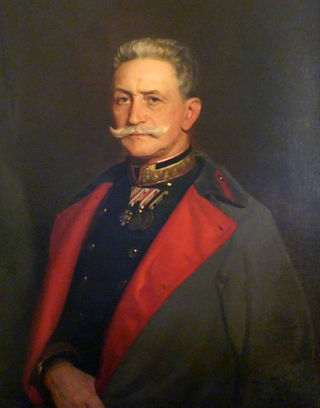
Franz Xaver Josef Conrad von Hötzendorf, sometimes anglicised as Hoetzendorf, was an Austrian general who played a central role in World War I. He served as K.u.k. Feldmarschall and Chief of the General Staff of the military of the Austro-Hungarian Army and Navy from 1906 to 1917. He was in charge during the July Crisis of 1914 that caused World War I. For years he had repeatedly called for preemptive war against Serbia to rescue the multiethnic Austro-Hungarian Empire, which was, he believed, nearing disintegration. Later on, he came to believe that the Dual Monarchy had taken action at the eleventh hour. The Army was also unprepared and he had resorted to politics to further his goals. He was unaware that Germany would relocate the majority of his forces to the Eastern Front, rather than in the Balkans. Conrad was anxious about invading Russia and when the Tsar's armies had captured the Carpathian mountain passes and were on the verge of invading Hungary, Italy entered the war on the side of the Allies. Nevertheless, the Austro-Germans cleared Galicia and Poland during the Gorlice–Tarnów Offensive in the summer of 1915 and later conquered Serbia in October with the help of Bulgaria. From 1915 his troops were increasingly reliant on German support and command. Without support from its German allies the Austro-Hungarian Army was an exhausted force.

Eduard Freiherr von Böhm-Ermolli was an Austrian general during World War I who rose to the rank of field marshal in the Austro-Hungarian Army. He was the head of the Second Army and fought mainly on the front of Galicia during the entire conflict. On 30 October 1940, Böhm-Ermolli was made a German Generalfeldmarschall.
The 1st Army was a field army-level command in the ground forces of Austria-Hungary during World War I. The army fought in Galicia and Russian Poland in 1914–15 before being briefly dissolved in the summer of 1916. Shortly afterwards, it was reformed and sent to fight in the Romanian Campaign for the next two years. The 1st Army was demobilized in April 1918 due to its heavy losses, following Romania's surrender.

Archduke Ferdinand Karl Joseph of Austria-Este was the third son of Archduke Ferdinand of Austria-Este and of his wife Princess Maria Beatrice Ricciarda d'Este, last member and heiress of the House of Este. For much of the Napoleonic Wars he was in command of the Austrian army.

The Military Order of Maria Theresa was the highest military honour of the Habsburg monarchy, Austrian Empire and Austro-Hungarian Empire.

Archduke Joseph Ferdinand of Austria was an Austro-Hungarian Archduke, military commander, from 1916 Generaloberst, and early advocate of air power. He later retired to life as a common citizen of Austria, and was briefly imprisoned in Dachau during the Nazi era.

Viktor Graf von Scheuchenstuel was a colonel general in the Austro-Hungarian Army. He was a general staff officer and division commander until World War I broke out. During World War I he was a Corps and Army commander serving in Serbia, Albania and Italy. During World War I he was promoted to Graf in the Austrian nobility. Following the end of World War I and the end of the Austro-Hungarian Empire, Scheuchenstuel retired from the military. He died in Vienna.
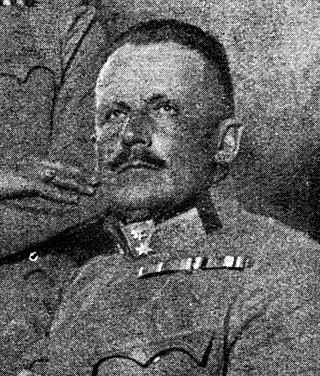
Viktor Weber Edler von Webenau, General in the Austro-Hungarian Army during World War I, military governor of Montenegro between 1916 and 1917 and head of the Austro-Hungarian armistice commission

Rudolf Stöger-Steiner Freiherr von Steinstätten was a colonel general in the Austro-Hungarian army and served as the last Imperial Minister for War not only to the Austro-Hungarian Empire but also to the ancient Habsburg monarchy which sat at its head.
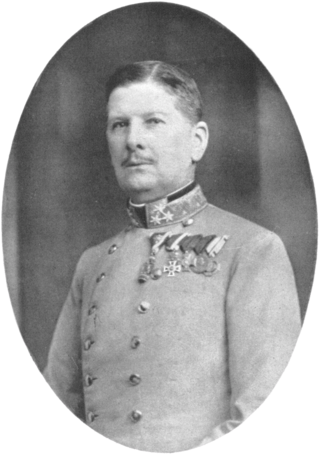
Rudolf Nikolaus Ritter von Brudermann was an Austro-Hungarian General der Kavallerie during World War I. He led Austria-Hungary's Third Army during the Battle of Galicia.
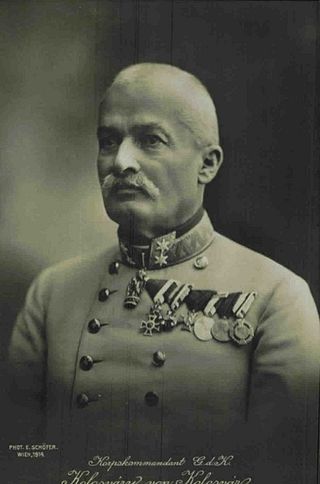
Dezső Kolossváry de Kolosvár was a Hungarian military officer in the Austro-Hungarian service and (briefly) a politician.

Paul Freiherr Puhallo von Brlog was a general of Austria-Hungary. During World War I, he commanded the Austro-Hungarian Army's 3rd and 1st Armies.

Robert Lamezan de Salins (1869–1930), also known as Robert Graf von Lamezan-Salins, was a Polish military officer and diplomat of aristocratic descent.
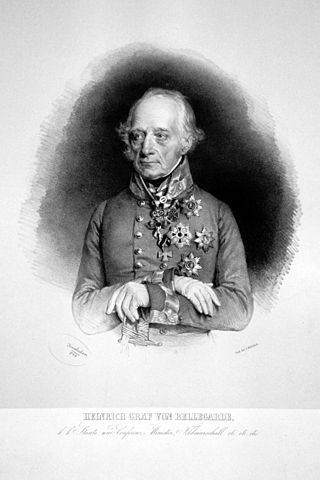
General of the Cavalry was a rank in the Imperial Army of the Holy Roman Empire, Imperial Army of the Austrian Empire and the Army of Austria-Hungary.

Camillo Bregant was a Major General, a colonel of the former 5th Styrian, Carinthian and Carniolan Dragoons "Nicholas I Emperor of Russia's Own" (Steirisch-Kärntnerisch-Krainerisches Dragoner-Regiment „Nikolaus I. Kaiser von Rußland“ Nr. 5) and a leading officer of the Austrian Armed Forces in the First Republic of Austria.

The leaders of the Central Powers of World War I were the political or military figures who commanded or supported the Central Powers.

Johann von Salis-Seewis also known as Johann Ulrich Graf von Salis-Seewis was an Austro-Hungarian military officer during World War I. An ethnic Croat, Salis-Seewis commanded the Croatian 42nd Honvéd Infantry Division first as part of the unsuccessful Serbian Campaign of 1914 and then on the Carpathian Front. On his return, he became military commander of Vienna before serving as the first military governor of the Military General Governorate of Serbia during the Austro-Hungarian occupation. He later commanded the 92nd Landwehr Infantry Division during the Romanian campaign and headed the Supreme Command in occupied Romania. After the dissolution of the Austro–Hungarian monarchy, following its defeat in the war, Salis-Seewis settled in Croatia where he got involved with the Croatian fascist Ustaše.

Juliusz Alfred Drapella was a Polish brigadier general of the Polish Armed Forces who was most notable during his service in World War II.

Karl Křitek was an Austro-Hungarian Army general. He notably commanded several armies during World War I.
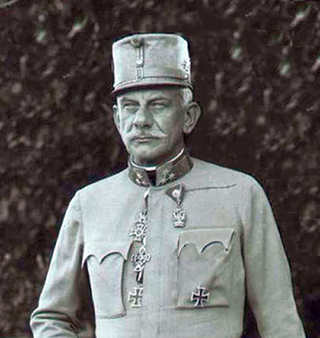
Josef Freiherr Roth von Limanowa-Łapanów, commonly known as Josef Roth was an Austro-Hungarian Generaloberst during World War I as well as a Privy Councilor while commanding the XIV Corps throughout the war.



















